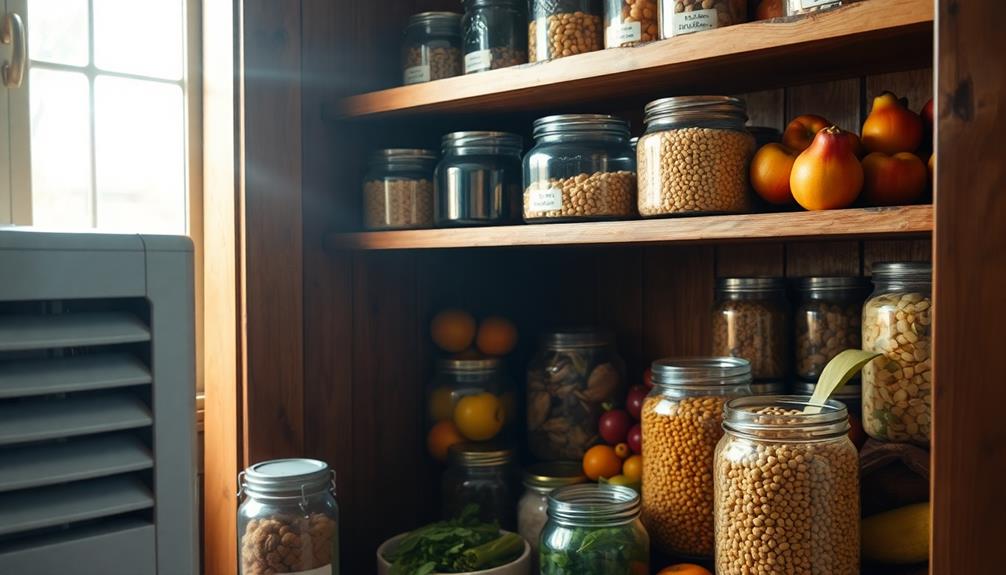Humidity can unexpectedly impact how your food lasts and tastes. High humidity accelerates spoilage and encourages mold growth, jeopardizing your safety. It also causes crispy snacks to become soggy and changes the texture of baked goods. Conversely, low humidity can dehydrate produce, stripping it of flavor and nutrients. Various types of food are affected differently by different humidity levels, ranging from meats to snacks. Monitoring these conditions is crucial for maintaining quality. Curious about how to control humidity for your food storage? There’s a lot more to learn about it!
Key Takeaways
- High humidity accelerates spoilage by promoting fungal and bacterial growth, compromising food safety and quality.
- Low humidity can dehydrate perishable foods, robbing them of natural juiciness and nutrients.
- Excess moisture can cause crispy snacks to become soggy, losing their crunch and altering flavor.
- Proper humidity levels are crucial for maintaining the texture of moisture-retaining foods, preventing hardening.
- Inadequate packaging in humid conditions can lead to spoilage and waste, affecting food integrity.
Effects of High Humidity
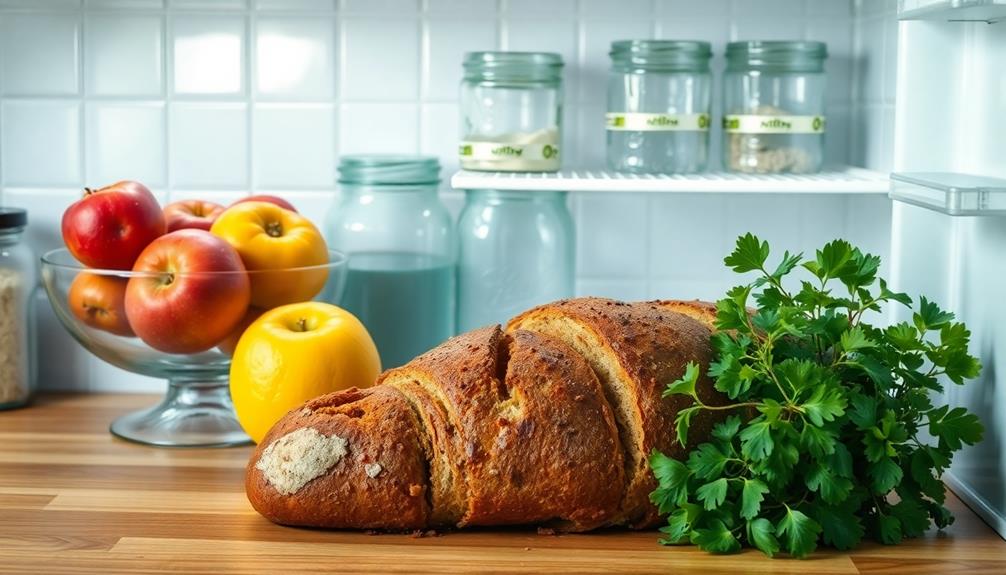
High humidity can drastically affect the quality and safety of your food. When humidity levels rise, they create an environment that accelerates food spoilage. You may notice that fungi and bacteria thrive in these conditions, which can compromise food safety.
This increased moisture absorption disrupts the natural balance in your food, leading to sogginess in crispy items and hardening in those that retain moisture. For example, dishes like Chinese Steamed Egg can become less appealing if humidity causes them to lose their silky texture.
As humidity levels rise, biochemical and microbial degradation occurs more rapidly, considerably reducing the shelf life of your perishable items. Fruits and vegetables are particularly vulnerable; enzymatic browning can increase, detracting from their visual appeal and freshness.
You might find your once-perfect apples turning brown faster than expected.
Moreover, high humidity can lead to the growth of fungi that release mycotoxins—substances that can pose serious health risks if ingested.
To keep your food safe, it's essential to manage humidity levels in your storage areas. By understanding the effects of high humidity, you can take proactive steps to protect your food quality and guarantee it remains safe for consumption.
Consequences of Low Humidity
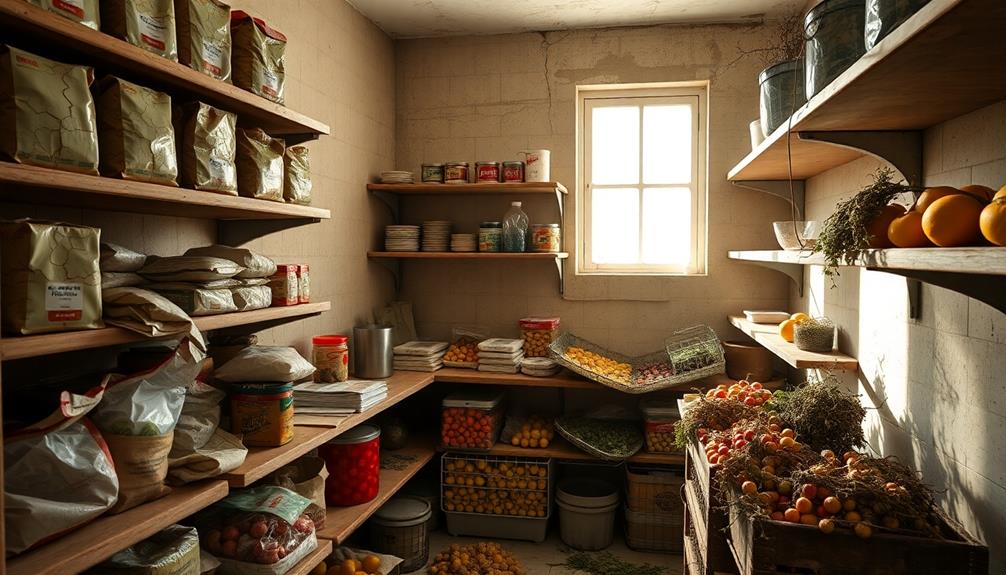
Low humidity often leads to significant dehydration of perishable foods, impacting their quality and appeal. When humidity levels within your food storage drop too low, you risk accelerated desiccation rates that can drastically diminish the natural juiciness of fruits and vegetables. This moisture loss compromises the structural integrity of these items, making them less appealing and marketable.
For instance, moisture-sensitive ingredients like fresh herbs used in dishes such as a creamy Nettle and Potato Soup can wilt and lose flavor when exposed to low humidity conditions.
In environments where humidity levels fall below the ideal range, especially below 10-15%, dried foods and spices can also suffer. Excessive moisture loss can alter flavor and aroma, making your stored items far less enjoyable.
If you're storing baked goods or confectioneries, low humidity can lead to an increased concentration of solutes, resulting in gritty or coarse textures that nobody wants.
Maintaining appropriate humidity levels is essential for effective food storage. If you rely on moisture-sensitive preservation methods like freeze-drying, low humidity can disrupt their balance, reducing your products' shelf life.
To keep your food fresh and flavorful, always monitor and adjust humidity levels within your storage spaces to prevent these negative consequences.
Impact on Food Texture
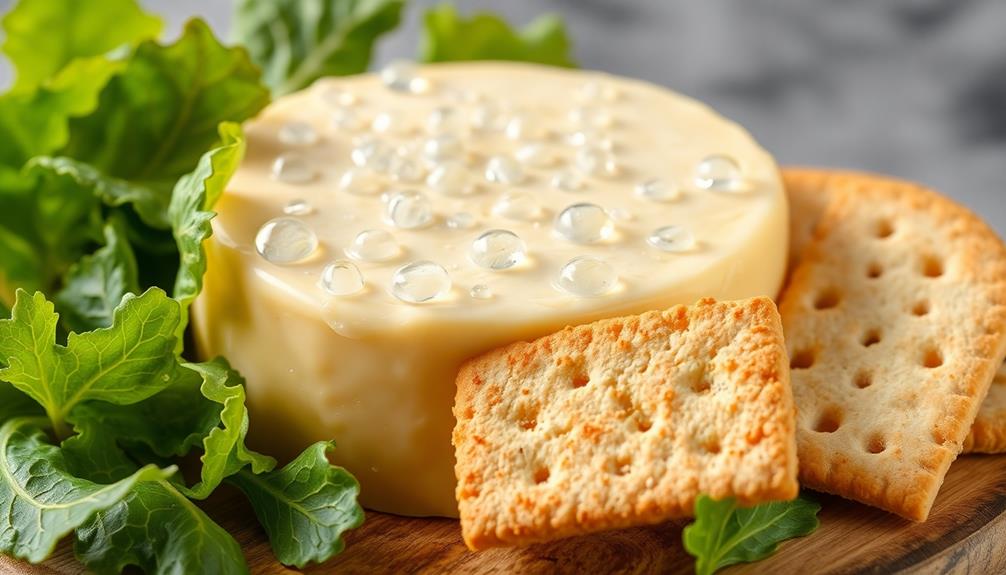
High humidity can quickly turn your favorite crispy snacks, like chips and crackers, into soggy disappointments.
Similarly, when storing items like Mushroom Masala, the moisture can lead to undesirable texture changes.
At the same time, moisture-retaining items, such as bread, can harden and lose their soft texture, making them less enjoyable to eat.
Understanding how humidity affects these textures is essential for maintaining the quality of your food.
Sogginess in Crispy Products
When humidity levels rise above 60%, you may notice that your favorite crispy snacks turn soggy and lose their delightful crunch. High humidity disrupts the natural moisture balance in these products, leading to a disappointing mouthfeel.
For instance, snacks like Dorayaki (Red Bean Pancake) can also suffer from changes in texture if not stored properly. Chips and crackers can absorb excess moisture, transforming from crispy to chewy in no time. This rapid degradation affects not just the texture, but also the overall quality of your snacks.
To help you understand this sogginess phenomenon, consider these points:
- Loss of Crunch: The satisfying snap of your favorite chips is replaced by a sad, limp texture.
- Mold Growth: Increased moisture can promote microbial growth, making your snacks unsafe to eat.
- Packaging Issues: Poorly sealed packaging can allow humidity to seep in, ruining your crispy treats.
- Flavor Deterioration: The delightful taste of your snacks can diminish as humidity alters their structure.
To keep your crispy snacks enjoyable, aim for humidity levels between 30-50%. By doing so, you'll help preserve the crunch that makes snacking so satisfying!
Hardening of Moisture-Retaining Items
Humidity can wreak havoc on moisture-retaining items like bread and cheese, causing them to harden and lose their appealing texture. When relative humidity levels are too high, these foods undergo hardening due to an imbalance in moisture. Excess moisture promotes the crystallization of sugars and alters proteins, leading to a less palatable result.
Here's a quick look at how different moisture-retaining items respond to high humidity:
| Item | Effect of Humidity |
|---|---|
| Bread | Hardens, becomes stale |
| Cheese | Loses creaminess, becomes crumbly |
| Cakes | Becomes dense and dry |
| Muffins | Loses airy texture |
| Soft fruits | Starts to rot quicker |
To preserve the intended texture and quality of these items, it's essential to maintain ideal humidity levels. Ideally, moisture-retaining products should be stored at 70-85% relative humidity. By doing so, you can avoid the hardening process and enjoy foods with their best mouthfeel and taste, ultimately enhancing your satisfaction.
Shelf Life Alterations

When humidity levels rise, you'll notice that microbial growth accelerates, putting your food at risk.
This moisture can also lead to nutritional degradation, affecting the quality of your meals, especially in ingredients like cassava which are sensitive to moisture.
Plus, high humidity may compromise packaging integrity, making it essential to monitor storage conditions closely.
Microbial Growth Acceleration
Excessive moisture in storage environments can quickly create a breeding ground for harmful microorganisms, leading to accelerated food spoilage.
When relative humidity rises above 60%, the risks to food safety multiply. Microbial growth can explode, threatening your meals with dangerous bacteria like E. coli and Salmonella. This is particularly concerning when storing ingredients like chicken, which can spoil rapidly if not kept at the right humidity levels, especially in dishes that require fresh produce and spices found in diverse cuisines, such as Muamba De Galinha.
It's vital to be aware of how humidity impacts your food.
Here are four unsettling effects of high humidity on food storage:
- Rapid Spoilage: Your perishable items can spoil days, even hours, faster than expected.
- Health Risks: Consuming contaminated food can lead to severe illnesses and hospital visits.
- Wasted Money: Higher spoilage rates mean more frequent trips to the store and wasted groceries.
- Invisible Threats: Mycotoxins from fungi can silently compromise your health without any obvious signs.
To combat these issues, maintaining relative humidity levels below 60% is essential.
Nutritional Degradation Impact
The impact of high moisture levels on food can drastically alter its nutritional quality and shelf life. When relative humidity rises, the biochemical and microbial degradation accelerates, leading to significant nutrient loss.
In food processing facilities, controlling humidity is essential; excessive moisture can enhance enzyme activity, especially in fruits and vegetables, resulting in faster spoilage and diminished nutritional value. For instance, just as the delicate flavors of traditional dishes like Agnolotti can be compromised by poor ingredient quality, so too can fruits and vegetables lose their appeal in damp conditions.
Enzymatic browning is a common issue in high humidity environments, which not only affects the food's appearance but also directly reduces its nutrient content. You might notice that fruits and vegetables stored in damp conditions look less appealing and may even taste bland due to the degradation of crucial nutrients.
Conversely, low moisture levels can cause dehydration, robbing perishables of their natural juiciness and necessary nutrients.
Ultimately, maintaining ideal humidity levels is key to preserving food quality and extending shelf life. If you store foods in high humidity, be aware that you're likely compromising their nutritional integrity.
Taking measures to regulate humidity can help guarantee that your food remains both safe and nutritious for as long as possible.
Packaging Integrity Concerns
High humidity levels often compromise packaging integrity, posing significant risks to food safety and longevity. When you store food in a high-humidity environment, you're inviting trouble. The moisture can lead to mold growth on packaging materials, jeopardizing the safety of what's inside.
In the same way that proper food preparation, like marinating beef for bulgogi, can enhance flavors, ensuring proper food storage can prevent spoilage. You mightn't realize it, but humidity fluctuations can have serious consequences:
- Tears and Weakness: Excess moisture weakens paper and cardboard, increasing the chances of tears that expose your food to contamination.
- Label Issues: Moisture can disrupt label adhesion, risking misidentification and regulatory compliance violations.
- Metal Dangers: Humidity-induced corrosion on metal packaging can lead to leaks and spoilage, making your food inedible.
- Condensation Concerns: High humidity can cause condensation within sealed packages, creating an environment perfect for spoilage and drastically reducing shelf life.
To protect your food, keep your storage area controlled and monitor humidity levels closely. Investing in proper packaging and storage solutions will help maintain the integrity of your food, ensuring it stays safe and fresh longer.
Role of Climate Control
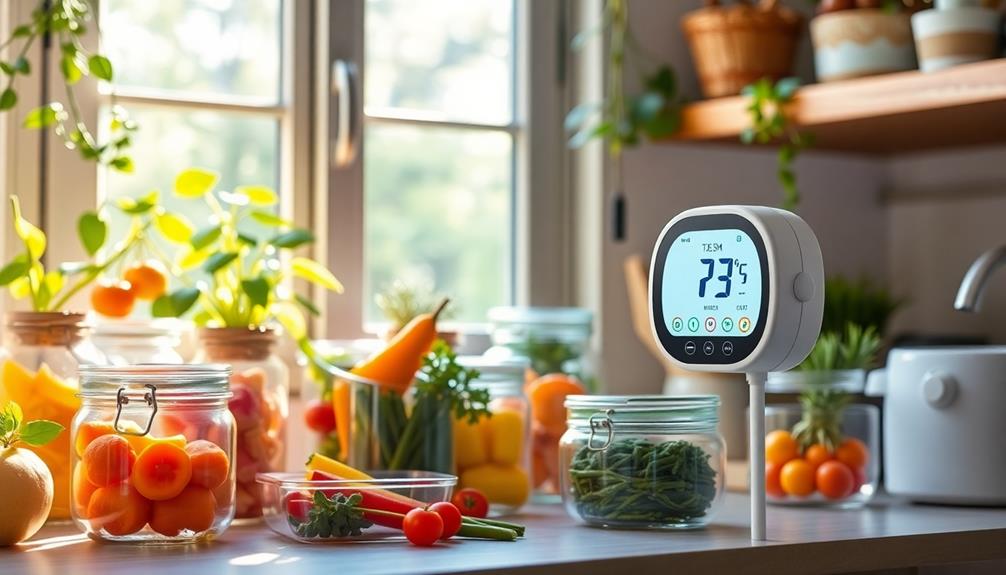
Effective climate control plays an essential role in food storage, guaranteeing that perishables remain fresh and safe for consumption. By maintaining ideal temperature and humidity levels, you prevent spoilage and extend shelf life.
For instance, high moisture foods require 85-95% relative humidity (RH) to stay properly preserved, while low moisture foods like grains and nuts benefit from 50-65% RH to avoid unwanted moisture absorption. Additionally, understanding how to store traditional dishes, such as Chilaquiles, can further enhance the preservation of flavors and textures in the kitchen.
Implementing proper ventilation systems is vital in reducing excess humidity, which helps mitigate the risk of mold growth and maintains a sanitary environment—essential for food safety. You can also utilize dehumidifiers tailored to specific food types, adjusting humidity levels as needed. Additionally, incorporating ventilation systems into food storage areas can prevent bacterial growth and ensure longer shelf life for perishable goods. As part of bathroom renovation trends, many homeowners are also focusing on improved ventilation to prevent mold and moisture buildup, which can have similar health and safety benefits. By addressing air quality and humidity in both food-related and living spaces, you can create a more hygienic and efficient environment.
In a food processing plant, effective climate control not only preserves the nutritional value and sensory attributes of food products but also guarantees compliance with regulatory standards. Regular monitoring through advanced sensors allows for real-time adjustments, keeping environmental conditions consistent.
This attention to detail enhances both product quality and safety, guaranteeing that your food storage practices meet the highest industry standards. By prioritizing climate control, you protect your investments and maintain the integrity of your food products.
Monitoring Humidity Levels
Maintaining ideal humidity levels is essential for preserving food quality and safety during storage. To achieve this, you need to focus on monitoring humidity levels carefully. Hygrometers are your best friends here; they measure relative humidity (RH) accurately, ensuring your food stays fresh.
Remember, different foods require different optimal humidity levels, so choose your measuring tools wisely. For instance, when storing ingredients like barley for dishes such as Yekolo (Roasted Barley), it's vital to maintain proper humidity to prevent spoilage.
Here are some effective ways to monitor humidity levels:
- Use calibrated hygrometers to guarantee accurate readings.
- Employ data loggers for continuous tracking and trend analysis, catching potential issues before they escalate.
- Utilize humidity indicators, like color-changing cards, for a quick visual reference.
- Integrate advanced sensors with microcontrollers for real-time data acquisition, allowing you to make immediate adjustments.
Regularly calibrating your hygrometers is essential for maintaining accuracy.
When you keep a close eye on humidity, you'll not only protect your food but also enhance its flavor and texture. Don't underestimate the impact of moisture control—it's key to enjoying your meals in their best form!
Frequently Asked Questions
How Does Humidity Affect Storage?
Humidity affects storage by influencing moisture levels in food. High humidity can cause spoilage and microbial growth, while low humidity helps preserve dried items. Keeping ideal humidity levels guarantees your food maintains its quality and longevity.
How Does Humidity Affect Food?
Humidity affects food by influencing its texture, flavor, and safety. It can keep fruits fresh or make chips soggy. You need to monitor humidity levels to guarantee your food stays tasty and safe to eat.
Why High-Humidity Can Cause Storage Problems?
High humidity can cause storage problems by fostering mold growth and accelerating spoilage. It also leads to soggy fruits and vegetables, weakens packaging materials, and creates clumps in dry ingredients, affecting overall food quality.
How Do You Store Food in Humid Climates?
"An ounce of prevention's worth a pound of cure." To store food in humid climates, use dehumidifiers, guarantee proper ventilation, monitor humidity levels, and choose moisture-resistant packaging to keep your food fresh and safe.
Conclusion
So, while you might think dry, crispy snacks are safe from humidity's clutches, just wait until they turn into chewy, sad excuses for their former selves. On the flip side, your favorite fruits can become shriveled relics in overly dry conditions. It's ironic how the air we can't see can wreak havoc on your pantry. By keeping an eye on humidity levels, you can save your food from becoming a soggy, stale disaster or a desiccated ghost.
